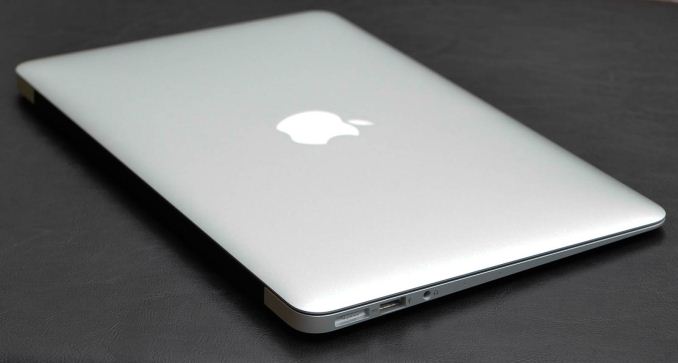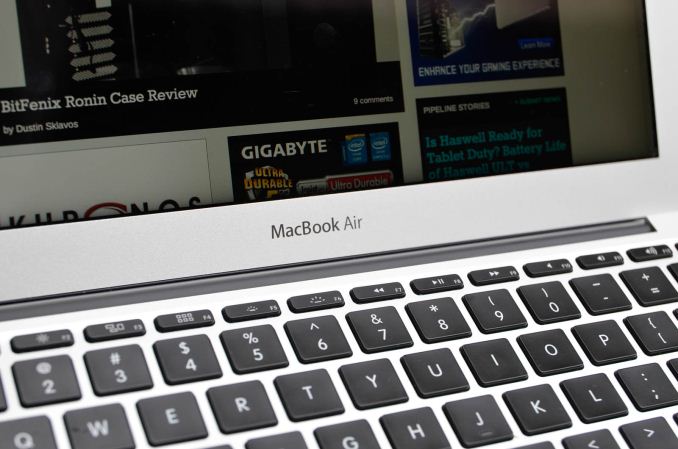The 2013 MacBook Air Review (11-inch)
by Vivek Gowri on August 9, 2013 1:45 AM ESTI come away from the 11” Air with mixed feelings. The modern silicon and generally better specced 2013 model has turned the 11” Air into a far more well rounded notebook than it has been in the past, at least in base $999 form. Unfortunately, the rest of the picture isn’t as rosy. The chassis and especially the display are starting to show their age, even more so than in the 13” Air, and anyone looking for any kind of performance gain over the previous generation is out of luck. The battery life is awesome, it really changes the way you approach the system, and I still love this form factor, but it’s hard to look at this and not compare it to an Ultrabook with a far better display for the same price.
I know Anand has long said that Macs and PCs don’t get cross shopped that often, but recently I’ve been asked for notebook advice by a lot of people who are completely platform agnostic. With the emphasis on web apps, there’s not much holding a normal consumer to one platform or the other unless they have a specific reason (gaming, media creation, familiarity) to ignore one of them. So when you look at something like Sony’s VAIO Pro 11, with a 1080p IPS 11.6” capacitive multitouch display, roughly similar specs (1.6GHz i5-4200U, 4GB, 128GB PCIe SSD), a half-pound lighter body (1.92lbs) with similar dimensions, and roughly the same price point—$1049 street price at the time of writing—it makes you think.
Sure, you lose some of the niceties you get with the new Air—802.11ac, Thunderbolt, the best touchpad in the world (you can’t find another laptop in the world with that combination of things at any price, at least until the next generation of MacBook Pros come out this fall)—and Windows 8 notebooks have never been able to match the battery life of Apple’s notebook line. Sony claims 7 hours of runtime on the 34Wh battery, though it’s worth noting there’s an optional slice battery that adds an extra 35.2Wh of capacity at the cost of a 0.6 lb weight gain. The real question though, how much of the added features would be worth sacrificing for that display upgrade?
On a more global scale, I feel like this is the end of the line for the current MacBook Air chassis. It’s been around for a handful of years now, and I honestly can’t see Apple keeping it around for another go-around. Particularly given how much smaller the Haswell ULT package is and how much less populated the 2013 Air PCB is relative to its predecessors, a sleeker redesign for Broadwell seems inevitable. I’d love to see them get this closer to or even under under the two pound mark without sacrificing the aluminum chassis, because that would really push the boundaries of mobility. I’d like smaller bezels around the LCD as well, though that is more dictated by the size of the keyboard and trackpad than anything else.
Also, it’s clear that something has to give with regards to the displays. I’m not sure when it’ll happen, but it’d be very odd for Apple to continue iterating a thoroughly modern, bleeding edge computer without changing the five year old display panel at some point. Considering all that Apple has done over the years to push notebook displays, it’d be very out of character for them to not address this issue within the next couple of years, particularly as the internal silicon gets so much more power efficient.
Given where this generation of Apple portables has gone, I think the upcoming MacBook Pros will be very interesting. Apple has really prioritized battery life, and the whispers of no dedicated graphics in either MBP makes things very interesting (if a bit concerning from a performance standpoint). If the 54Wh battery in the Air 13” gets to 11 hours of battery runtime without too much trouble, just imagine what the 74Wh battery in the rMBP13 or the 95Wh battery in the rMBP15 can do with Haswell’s power efficiency, particularly if the updated MBP13 gets a single chip 28W Haswell ULT part with Iris graphics. I get chills just thinking about it.
But in terms of the 11” Air, the main point of comparison that needs to be addressed is the 13” Air. I know I covered this in the intro, but it’s worth revisiting. The 13” is without question the better computer, and if you’re looking to replace a laptop, it’s definitely the way to go. I like the 11” Air as a tablet replacement—I’d rather carry this than my iPad on almost every day of the week (unless I need the built-in LTE). It’s almost impossible to use as a primary system though, the way you can with the larger Air. The difference-maker relative to the 13” Air isn’t the weight, since that’s still quite light at 2.96lbs, but the footprint. While the 11” Air is small enough to fit basically anywhere an iPad can be carried, the 13” is much closer to the size of a real notebook. The fact that I’d be making minimal compromises to carry a real notebook versus the iPad is startling, and if you need the most mobile productivity machine you can get, it’s hard to top this. As we start to see more Haswell-based ultraportables and tablets, particularly when the Haswell ULX (Y-series) parts hit, this might change, but for now I feel pretty comfortable saying that.













139 Comments
View All Comments
solipsism - Saturday, August 10, 2013 - link
Your first paragraph compares a RAIDed system to a single drive system that then says it's "just as fast" then your 2nd paragraph argues that the MBA can't benefit from having a PCIe SSD over a SATA SSD.Do you honestly don't know what faster storage can do for disk reads and writes? Do you think Anand lied about the results of his 2013 13" MBA comparison?
128K Sequntial Writes:
2010 MBP — 89 MB/s
2013 MBA — 714.2 MB/s
How exactly does that not offer any benefit?
ESC2000 - Saturday, August 10, 2013 - link
Anyone who reads this review and thinks there is anti apple bias is himself biased toward Apple. You've made your position pretty clear.Anandtech has done three major articles/reviews of Mac laptops in the past two months and basically none on any other laptops. That should be pro Apple enough for you.
ESC2000 - Saturday, August 10, 2013 - link
Just to be clear, that is a response to darwinosx not Vivek.IHateMyJob2004 - Friday, August 9, 2013 - link
$999? Who would spend that much on a small screen laptop? Only fools ....solipsism - Friday, August 9, 2013 - link
Because the performance, quality and utility of a device is based solely on the size of the display? I guess that means it's foolish to even spend $200 on a cheap cellphone since the display on those is much smaller¡purerice - Friday, August 9, 2013 - link
Good point. Actually in the end you end up paying over $600 for that $200 cell which just adds to your point. This can handle 1600p resolution on an external display. Not for Crysis but it will run Excel fine.I used to have a 12" laptop with 1024x768 screen that I attached to a Dell 2407 when at my home office. At the time 4.6 lb (2.1kg) was light for a laptop. Having a small laptop for the road that you can plug in to a beautiful display at home is the best of both worlds. I would rather have a fully functional, 2.4 lb 11" laptop with SSD for $1000 than 15" laptop that weighs 3x and has a 5400 rpm hard drive for $600.
I replaced that 12" laptop with a 6 lb, 15" Penryn-based Dell laptop that got 90 minutes of battery life new, that was about $600. I use it when I have to for work and looking back I gladly would trade portability, HD speed, and battery life for the higher screen resolution, a little speed, and $400. Most gladly.
Though now that Toshiba's IB-based U925 is no longer available, I am hoping they replace it with a Haswell version. Touchscreen+tablet mode are features I would rarely use, but in certain cases they would be extremely helpful.
jutre - Friday, August 9, 2013 - link
And what about the RAM ? Is 4GB (not up-gradable) acceptable for anybody ? If you buy your laptop today, it is for using it for the next couple years. I guess forking 100$ for the extra RAM in order to futureproof your laptop a no brainer ?purerice - Friday, August 9, 2013 - link
I think so. LPDDR3 memory that Apple uses here and Sony uses with the Vaio Duo is (almost?) always attached to the motherboard, unlike most DDR3L memory. There will likely be other bottlenecks for sure, but especially with shared vram, the 4GB is closer to 3-3.5GB.name99 - Saturday, August 10, 2013 - link
Are you people retarded?This is not a machine being sold to run huge Mathematica simulations, or to host 4 simultaneous VMs. It's a machine sold to people who perform "normal" computing tasks, basically email, web, reading PDFs, maybe MS Office, maybe some arranging photos, maybe some light gaming.
You're like people who look at the specs for a 2-door sedan and complain "But what if I want to use it to tow my boat 24 hours a day?"
If it doesn't fit your computing needs, don't fscking buy it. It doesn't meet my needs (which DO include substantial Mathematic usage), so I bought a quad-core 16GB 15" rMBP. The difference is I don't waste everyone's time by claiming that the entire damn world has the same computing needs that I do.
Does it meet my GF's needs? My mother's needs? My two sister's needs? Yes, yes and yes.
My programmer brother's needs? No.
That's why Apple makes multiple laptops!!!
TheinsanegamerN - Sunday, August 11, 2013 - link
dude, roid rage much?nobody is retarded here. they were having a legitimate conversation on the ram found in the macbook air, and then you butted in.
normal users can run over 4 GB of ram usage. ask anyone who runs multiple tabs while a video is playing in the background.
and nobody was claiming that the world has the same computational needs as them.
so kindly shut up and go back to your "Mathematical equations" and leave socializing to people who are not incredibly rude morons.